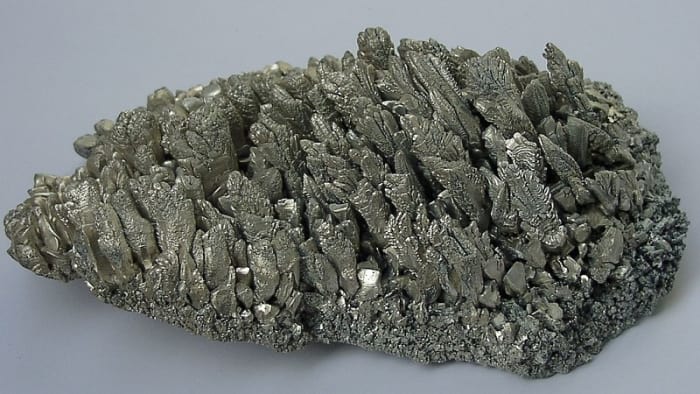Characteristics of magnesium, qualitative reactions
General properties of magnesium and its compounds

Magnesium is an element of the second group of the third period of the Periodic Table (atomic number: 12). It is an alkaline earth metal (other members of this group include beryllium Be, calcium Ca, strontium Sr, barium Ba and radium Ra).
In nature, magnesium is encountered in the form of a mineral – for example, the abundant minerals dolomite CaCO₃·MgCO₃ and magnesite MgCO₃.
Physical properties
Magnesium is a silvery white metal with high electrical conductivity. In ordinary conditions, its surface is covered with an oxide film, MgO, which can be removed by heating in air to 600 ᵒC (1112 ᵒF). Combustion of magnesium after the disintegration of the oxide film starts immediately with a blinding white flash.

3 stable isotopes of magnesium may be encountered in nature (isotopes have an identical atomic number, but different mass numbers) – with mass numbers 24, 25 and 26 (the most common isotope is the first – its content in a mixture of isotopes reaches 78-79%). The longest-lived radioactive isotope of magnesium is Mg with an atomic number of 28 (half-life – 20.9 hours).
Obtaining magnesium
There are 2 methods for obtaining magnesium – by electrolysis of a flux of its salt and thermic reduction by coal. Electrolysis of magnesium bromide takes place as follows:
К(-): Mg²⁺ + 2е = Mg⁰;
A(+): 2Br⁻ - 2е = Br₂;
MgBr₂ = Mg + Br₂.
Magnesium is obtained thermally from the oxide by the reduction by coal or silicon with heating:
MgO + C = Mg + CO ((so that the magnesium is not contaminated with impurities, only its oxide must be present in the reaction mixture – if a mixture of oxides is reduced, all metals present will be reduced by coal).
Magnesium can be reduced from dolomite without mixtures of calcium by silicon:
-
CaCO₃·MgCO₃ = CaO + MgO + 2CO₂ (when dolomite is baked, 2 oxides form – magnesium and calcium);
-
CaO + 2MgO + Si = 2Mg + CaSiO₃ (in the reduction of a mixture of calcium and magnesium oxides, magnesium can be obtained without a mixture of calcium, as calcium oxide turns to silicate).

Chemical properties of magnesium
In the combustion of magnesium in air, 2 compounds can form – magnesium oxide and magnesium nitride (reactions take place with the release of a great deal of heat and light):
-
2Mg + O₂ = 2MgO;
-
3Mg + N₂ = Mg₃N₂.
Magnesium can also burn in carbon dioxide:
2Mg + CO₂ = 2MgO + C.
Magnesium does not self-combust, so heating is required to carry out these reactions. With heating, magnesium reacts with many non-metals:
-
Mg + S = MgS (magnesium sulfide forms);
-
Mg + Cl₂ = MgCl₂ (magnesium chloride forms);
-
Mg + H₂ = MgH₂ (magnesium hydride forms).

With heating, magnesium reacts with water, with the formation of magnesium oxide or hydroxide and hydrogen:
- Mg + 2H₂O = Mg(OH)₂ + H₂.
Magnesium also dissolves in diluted acids, forming salt and hydrogen gas:
- Mg + H₂SO₄ = MgSO₄ + H₂;
Click here for interesting experiments with metallic magnesium.
Concentrated sulfuric acid reacts with magnesium as follows:
- 4Mg + 5H₂SO₄ = 4MgSO₄ + H₂S + 4H₂O.
Depending on the concentration of nitric acid, the following reactions with magnesium are possible:
-
4Mg + 10HNO₃ = 4Mg(NO₃)₂ + N₂O + 5H₂O (if the acid is diluted);
-
2Mg + 6HNO₃ = 2Mg(NO₃)₂ + N₂O + NO + 3H₂O (if the acid is of 30% concentration).
Qualitative reactions to magnesium
There are several methods for determining the presence of magnesium ions in solutions of magnesium salts:
- When carbonate ions react with magnesium ions, magnesium hydroxycarbonate forms in a soluble sediment:
2Mg²⁺ + 2CO₃²⁻ + H₂O = (MgOH)₂CO₃ + CO₂;
The sediment dissolves in acids:
(MgOH)₂CO₃ + 4Н⁺ = 2Mg²⁺ + 3H₂O + CO₂.
- When hydrophosphate ions react with magnesium ions in the presence of ammonium chloride and ammonia, a crystalline sediment of dual magnesium-ammonium phosphate forms:
Mg²⁺ + HPO₄²⁻ + NH₃·H₂O = MgNH₄PO₄ + H₂O.
The reaction can be examined by crystalline microchemical analysis – it can be carried out on a glass slide, and the crystals that form can be observed under a microscope.
When carbonate ions react with a solution of magnesium salt, the white sediment MgCO₃ forms:
Mg²⁺ + CO3²⁻ = MgCO₃ (but many other alkaline earth metals give the same reaction).

Organic compounds can also give a qualitative reaction to magnesium – when magneson-I or II reacts with magnesium ions in the absence of ammonium ions, the solution turns blue.
Oxyquinoline in an alkaline medium gives a greenish-yellow crystalline sediment when it reacts with magnesium ions.
Water hardness
Along with calcium ions, the presence of magnesium ions in water determine its hardness. Temporary water hardness is caused by the presence of magnesium and calcium hydrocarbonates (Mg(HCO₃)₂ и Ca(HCO₃)₂). This type of hardness can be eliminated by boiling, as these hydrocarbonates decompose when heated:
-
Mg(HCO₃)₂ = Mg(OH)₂ + CO₂;
-
or 2Mg(HCO₃)₂ = (MgOH)₂CO₃ + 3CO₂ + Н₂О;
-
Ca(HCO₃)₂ = CaCO₃ + CO₂ + H₂O.
Constant hardness is caused by the presence of magnesium and calcium salts – for example sulfates and chlorides MgCl₂ (CaCl₂), MgSO₄ (CaSO₄).
Magnesium salts have found application in medicine – for example magnesium oxide MgO neutralizes excess acid of the stomach juice. Magnesium oxide is also used in the manufacture of refractory crucibles, in photography, and in batteries.